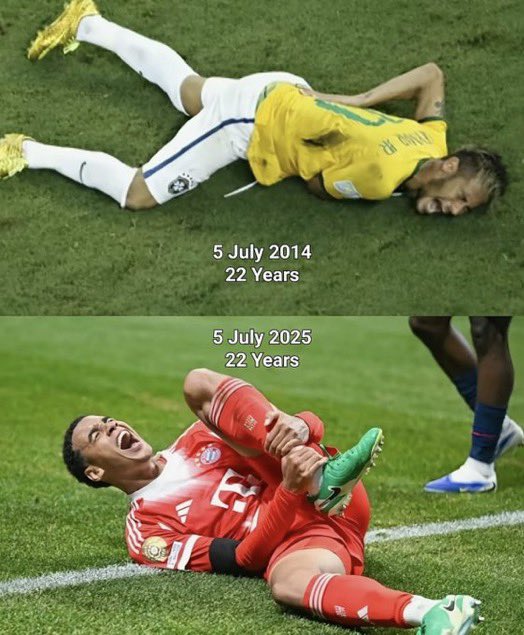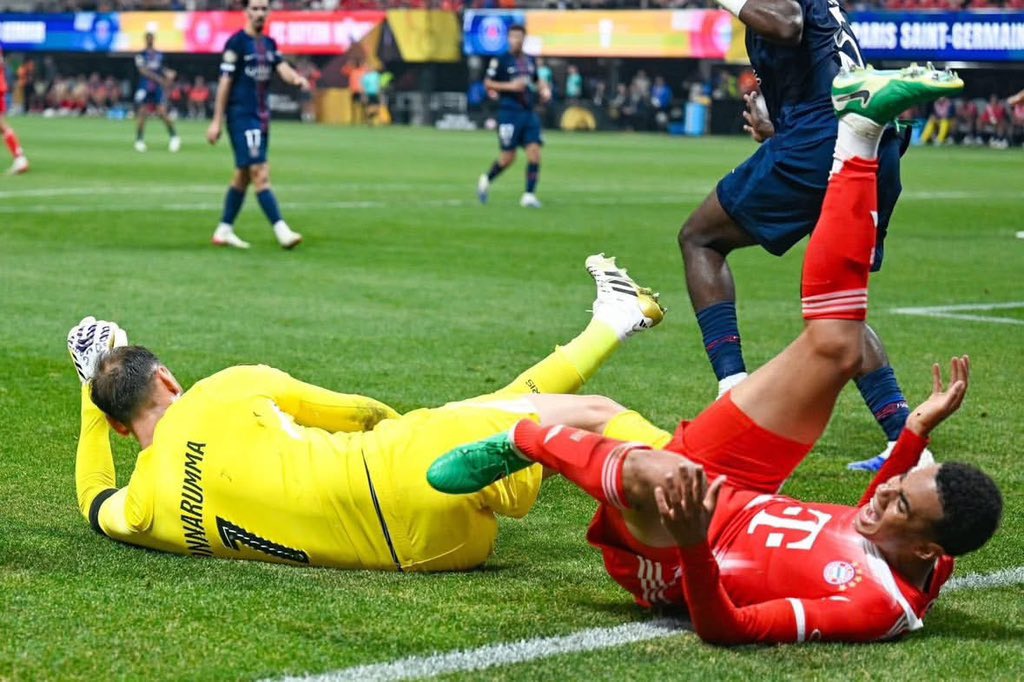
Football, a game of passion and precision, often provides joy, triumph, and unforgettable moments. But at times, it delivers cruel irony—painful reminders that even the brightest stars can fall. This past 5th of July, the football world witnessed one such moment when Jamal Musiala, the dazzling German talent, collapsed in agony during a Bayern Munich match. The date? 5 July 2025. His age? 22 years old.
For those with deep memories of the game, it was impossible not to think back exactly 11 years to when Neymar Jr., Brazil’s golden boy, suffered a devastating back injury during the 2014 FIFA World Cup—on the exact same date, and at exactly the same age.
The images are haunting. Neymar lying face-down in tears wearing the yellow of Brazil, and Musiala curled on the ground in Bayern red, clutching his leg in visible pain. Different players. Different continents. But an identical mix of talent, expectation—and tragedy.
⚠️ The Neymar Incident: A Nation’s Hopes Crushed
It was July 5, 2014, when Neymar was brought down by a reckless challenge from Colombia’s Juan Camilo Zúñiga in the quarterfinals of the World Cup. The tackle fractured a vertebra in Neymar’s spine, ruling him out of the rest of the tournament. Brazil, already dependent on his creative spark, collapsed days later in a shocking 7-1 loss to Germany.
The nation mourned, and Neymar’s tears became symbolic of more than just physical pain. At 22, he was the face of Brazilian football—carrying the hopes of millions. The injury wasn’t just a physical setback; it altered the trajectory of that World Cup and left emotional scars for years.
💥 History Repeats: Jamal Musiala’s Heartbreaking Fall
On 5 July 2025, during a pre-season tournament match between Bayern Munich and Inter Milan, the unimaginable happened. Jamal Musiala, one of Europe’s most electrifying talents, went down under pressure from a hard challenge. He immediately signaled for medical assistance. The stadium fell silent. Musiala gripped his ankle, writhing in pain—echoing Neymar’s anguish from 2014.
Scans later confirmed a torn ankle ligament, with early reports suggesting Musiala could be out for up to 6–8 months—a major blow for Bayern Munich and the German national team ahead of crucial UEFA Nations League matches.
And as the football world processed the injury, fans quickly drew a chilling parallel:
5 July 2014: Neymar, injured at 22
5 July 2025: Musiala, injured at 22
The symmetry is stunning—and deeply emotional.

🔁 Social Media Erupts: “This Can’t Be Real”
Football fans, journalists, and players took to social media in disbelief.
One viral tweet read:
“Is football cursed on July 5th for 22-year-old superstars? First Neymar. Now Musiala. I’m heartbroken.”
Another post showed the side-by-side images of Neymar and Musiala in pain, with the caption:
“11 years apart. Same date. Same age. Same pain. Football writes its own stories.”
Thousands of fans replied with support, heartbreak, and even superstition. Some speculated whether the date was “jinxed,” while others offered emotional encouragement.
🤝 Neymar Reaches Out: “I Know That Pain”
Neymar, now 33 and playing in Saudi Arabia, responded with a touching message on Instagram:
“Jamal, I know that pain. I lived it. You’re young, strong, and full of life. This won’t stop you. Let it build you. Come back even greater. I’m with you.”
The message garnered millions of likes and was reshared by top football accounts, bringing together two generations of football brilliance connected by one tragic day.
🧠 Pressure on Young Stars: Are We Asking Too Much?
The Musiala-Neymar coincidence is more than just an eerie date. It exposes a broader issue: are young players under too much pressure?
Jamal Musiala debuted for Bayern at just 17. By 20, he was already the creative engine of both club and country. With expectations mounting and constant media scrutiny, the pressure on young athletes today is enormous.
Injuries, while physical in nature, often stem from mental burnout, overuse, and insufficient recovery time. Footballing legend Lothar Matthäus commented:
“These players are humans, not machines. We must protect them. Too much football, too young, leads to risk.”
💬 Messages of Support Flood In
The outpouring of support for Musiala has been overwhelming:
- Thomas Müller, his longtime teammate: “It’s tough to watch. But Jamal has the mentality of a champion. We’ll wait for him. We need him.”
- Leroy Sané, who was subbed in after Musiala’s injury: “It shook us. The dressing room was silent. We’re all hurting.”
- Hansi Flick, Germany’s national coach: “Jamal is our diamond. We will support him every step of the way.”
Even rival fans posted heartfelt messages wishing him a swift recovery.
🛡️ Bayern Munich Reacts: “He Will Come Back Stronger”
Bayern Munich issued an official statement:
“We regret to confirm that Jamal Musiala has suffered a ligament injury that requires a lengthy recovery. Jamal is a fighter. Our medical team will ensure he receives the best treatment. He will return stronger and more determined.”
The club is reportedly already planning rehabilitation programs tailored to minimize long-term impact, including support from sports psychologists, dietitians, and physiotherapists.
🌟 A Legend in the Making, Delayed—Not Destroyed
At 22, Musiala has already achieved what many players can only dream of—Champions League nights, Bundesliga glory, and global acclaim. This injury is a setback, yes. But it doesn’t define his story.
Neymar’s career, despite his injury, flourished. He went on to become one of the most influential players of his generation. Musiala, with his humility, technique, and brilliance, can do the same.
As one fan posted:
“Neymar rose. So will Musiala. You can’t stop magic.”
📅 July 5: No Longer Just a Date
From now on, 5 July will stand not just as a random date in football’s calendar, but as a symbolic day—one that reminds us of the fragility of talent, the shared humanity of superstars, and the resilience required to overcome pain.
Musiala’s journey continues. And the football world will be watching—eager, hopeful, and inspired—for the day he dances with the ball again.